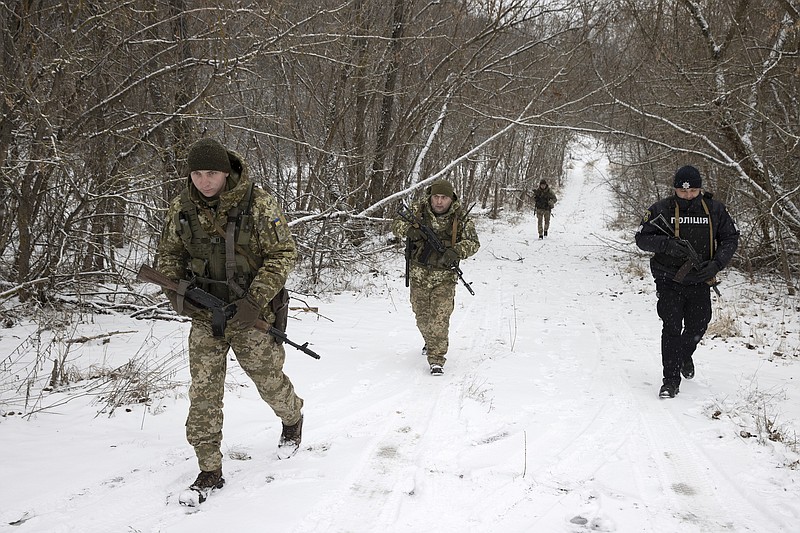Grave may have been the mistakes of Donald Rumsfeld, but George W. Bush's first defense secretary did have a gift for memorable phrases. One of them - "weakness is provocative" - explains the predicament we again find ourselves in with Russia's belligerence against Ukraine and NATO.
Let's recap how we got here.
- In August 2008, Russia invaded Georgia and took control of two of its provinces. The Bush administration protested but did almost nothing. After Barack Obama won the White House that fall, he pursued a "reset" with Russia. In 2012, he cut U.S. force levels in Europe to their lowest levels in postwar history and mocked Mitt Romney for calling Russia our principal geopolitical threat.
- In September 2013, Obama famously retreated from his red line against Bashar Assad's use of nerve gas in Syria, accepting instead a Russian offer of mediation that was supposed to have eliminated Assad's chemical arsenal. That arsenal was never fully destroyed, but Vladimir Putin took note of Obama's palpable reluctance to get involved.
- In February 2014, Russia used "little green men" to seize and then annex Crimea. The Obama administration protested but did almost nothing. Russia then took advantage of unrest in eastern Ukraine to shear off two Ukrainian provinces while sparking a war that has lasted seven years and cost more than 13,000 lives. Obama responded with weak sanctions on Russia and a persistent refusal to arm Ukraine.
- In 2016, Donald Trump ran for office questioning how willing America should be to defend vulnerable NATO members. In 2017 he tried to block new sanctions on Russia but was effectively overruled by Congress. The Trump administration did ultimately take a tougher line on Russia and approved limited arms sales to Ukraine. But Trump also tried to hold hostage military assistance to Ukraine for political favors before he was exposed, leading to his first impeachment.
Which brings us to Joe Biden, who ran for office promising a tougher line on Russia. It has been anything but. In May, his administration waived sanctions against Russia's Nord Stream 2 gas pipeline to Germany, which, when operational, will increase Moscow's energy leverage on Europe. Since coming to office, the administration has done little to increase the relatively paltry flow of military aid to Ukraine. In the face of a Russian invasion, it will be as effective as trying to put out a forest fire by peeing on it.
Then there was the fiasco of our withdrawal from Afghanistan. "In the aftermath of Saigon redux," I wrote at the time, "every enemy will draw the lesson that the United States is a feckless power." The current Ukraine crisis is as much the child of Biden's Afghanistan debacle as the last Ukraine crisis was the child of Obama's Syria debacle.
Now the administration is doubling down on a message of weakness by threatening "massive consequences for Russia" if it invades Ukraine, nearly all in economic sanctions. That's bringing a knife to the proverbial gunfight.
Imagine this not-so-far-fetched scenario. Russian forces move on a corner of Ukraine. The U.S. responds by cutting off Russia from the global banking system. But the Kremlin (which has built its gold and foreign-currency reserves to record highs) doesn't sit still. It responds to sanctions by cutting off gas supplies in midwinter to the European Union - which gets more than 40% of its gas from Russia. It demands a Russia-Europe security treaty as the price of the resumption of supplies. And it freezes the U.S. out of the bargain, at least until Washington shows goodwill by abandoning financial sanctions.
Such a move would force Washington to either escalate or abase itself - and this administration would almost certainly choose the latter. It would fulfill Putin's long-held ambition to break the spine of NATO. It would further entice China into a similar mindset of aggression, probably against Taiwan.
It would be to America's global standing what the Suez Crisis was to Britain's. At least Pax Britannica could, in its twilight, give way to Pax Americana. But to what does Pax Americana give way?
What can the U.S. do instead? We should break off talks with Russia now: No country ought to expect diplomatic rewards from Washington while it threatens the destruction of our friends. We should begin an emergency airlift of military equipment to Ukraine, on the scale of Richard Nixon's 1973 airlift to Israel, including small arms useful in a guerrilla war. And we should reinforce U.S. forces in front-line NATO states, particularly Poland and the Baltics.
None of this may be sufficient to stop Russia from invasion, which would be a tragedy for Ukrainians. But Putin is playing for bigger stakes in this crisis - another sliver of Ukrainian territory is merely a secondary prize.
What he really wants to do is end the Western alliance as we have known it since the Atlantic Charter. As for the U.S., two decades of bipartisan American weakness in the face of his aggression has us skating close to a geopolitical debacle. Biden needs to stand tough on Ukraine in order to save NATO.
The New York Times
